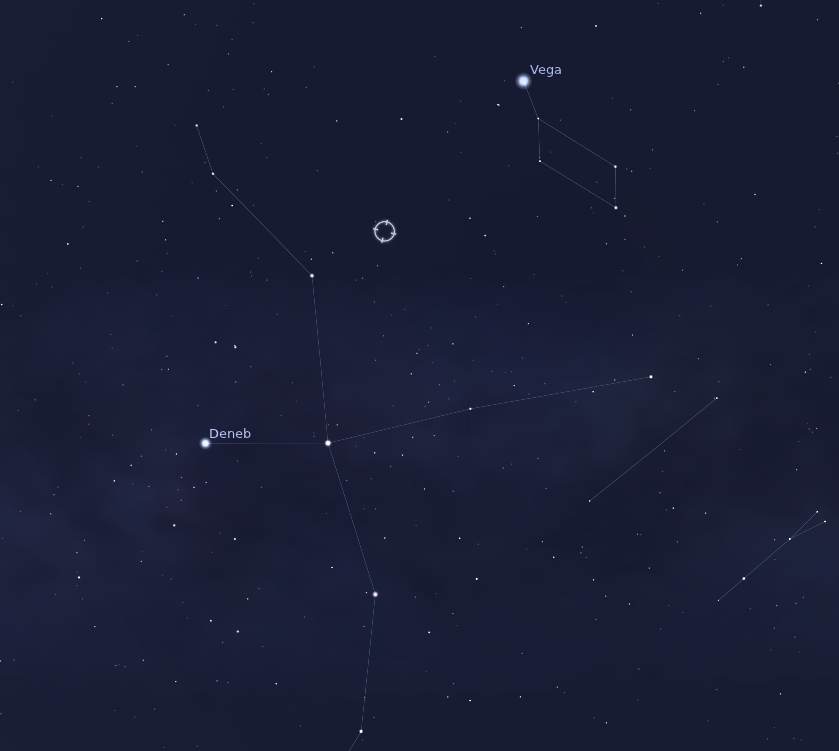
 Copyright © Michael Richmond.
This work is licensed under a Creative Commons License.
Copyright © Michael Richmond.
This work is licensed under a Creative Commons License.
RR Lyr stars are named after the first member of their class to be studied in depth: RR Lyrae.

This star was first noticed to vary in brightness by Wilhemina Fleming, who measured its properties on photograph plates taken as part of the Henry Draper project. Pickering et al., ApJ 13, 226 (1901) describe the star this way:

In 1913, Kiess, PASP 25, 121 (1913) reported on photometric and spectroscopic measurements made at Lick Observatory. He noticed that the radial velocity of the star varied in phase with its brightness:
RR Lyrae possesses the characteristic that is so pre-eminently a distinguishing feature of the Cepheid-Geminid variables -- namely, that maximum light occurs at the time of maximum velocity of approach toward the observer.
So far, so good. But his interpretation of this observation was quite different from our current ideas. He continued:
Hence, there can be little doubt but that the light variations of the bright star are due, directly or indirectly, to the influence of the less brilliant member of the system. That eclipses are in no way responsible for the observed light variations is evidenced by the relations existing between the light and velocity curves.
So, at that time, astronomers believed that variables of this sort were members of binary systems.
Over the next few decades, with more and better measurements to guide them, astronomers realized that RR Lyrae and its kin were single stars which pulsed: their outer layers expand and contract, growing hotter and cooler as they move.
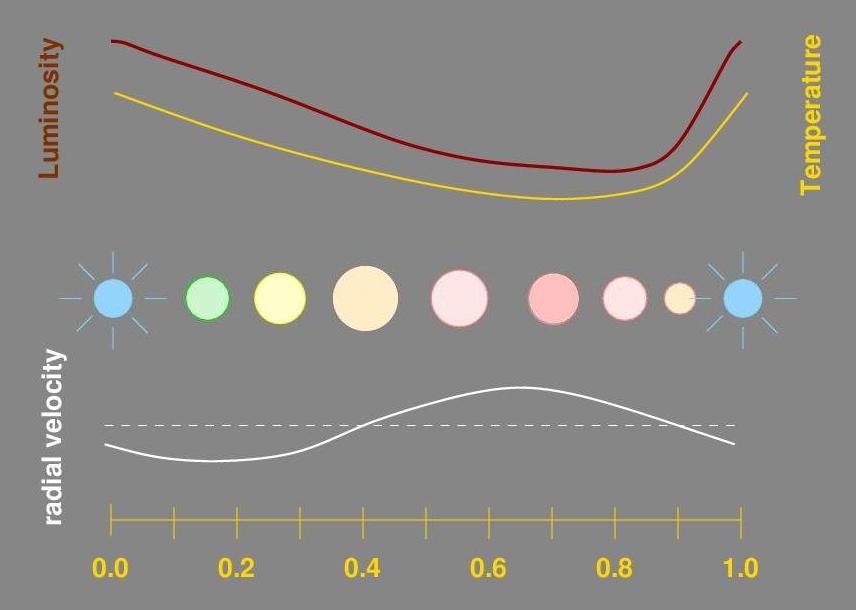
Why do these stars expand and contract in this way? Well, in a way, these stars behave like a pot of water sitting on a hot stove:
The key is the behavior of a certain zone within the star's atmosphere which contains the doubly-ionized helium ion He++.
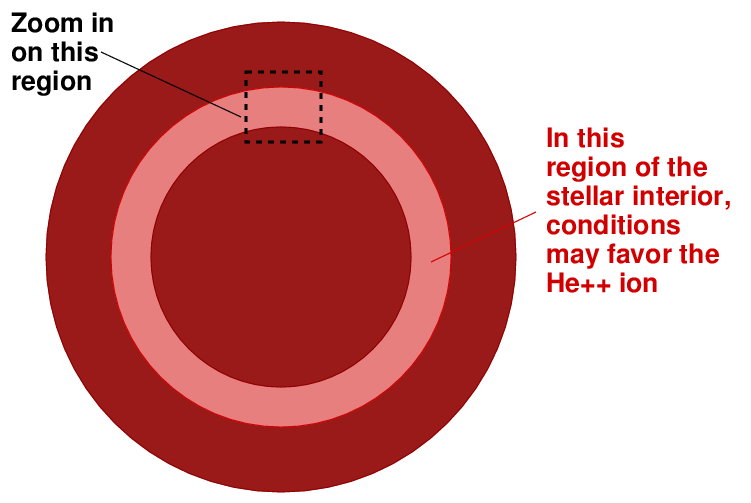
This ion (and its two free electrons) scatters light much more efficiently than a singly-ionized helium atom (and its single free electron), so it acts like the lid on a pot. Radiation pressure from the inner regions pushes the material in this zone upward; but as it rises and grows less dense and cooler, the He++ ions capture electrons, turning into He+ ions. Eventually, when the opacity drops far enough, the trapped radiation escapes, and the gas falls back toward the hotter inner regions.
RR Lyr stars serve as excellent tracers of structure within our Milky Way Galaxy, and as distance indicators for other galaxies within the Local Group. What makes them so useful?
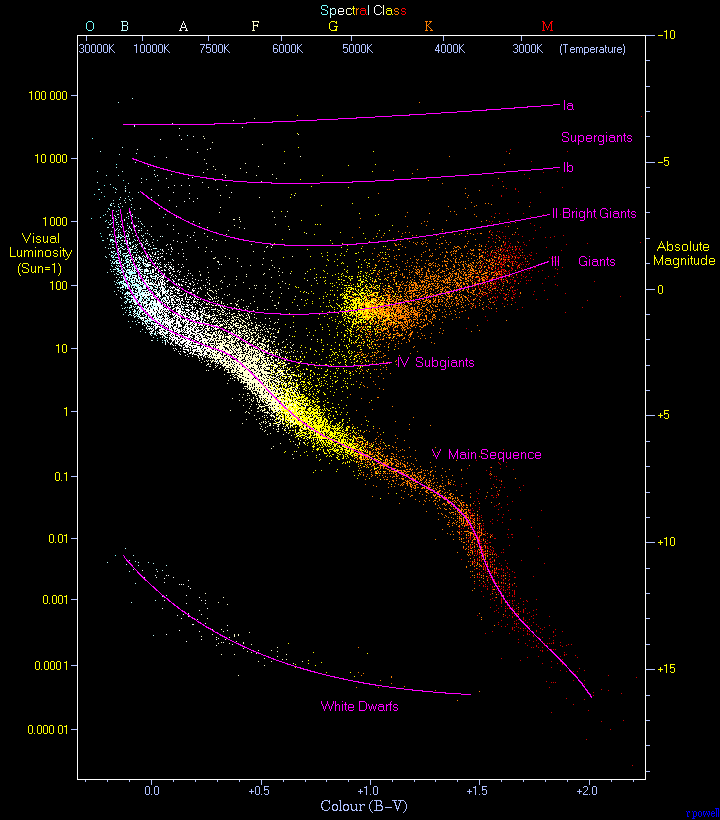
Image courtesy of
Atlas of the Universe


Q: Below are light curves for two RR Lyr stars in dwarf galaxies in the Sculptor Group. What is the distance modulus to the Sculptor Group?
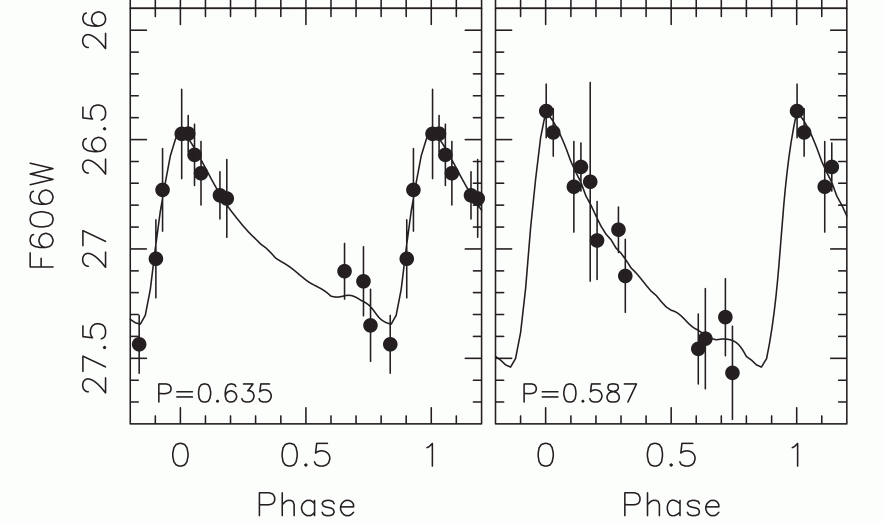
Figure taken from
Da Costa et al., ApJ 708, 121 (2010)
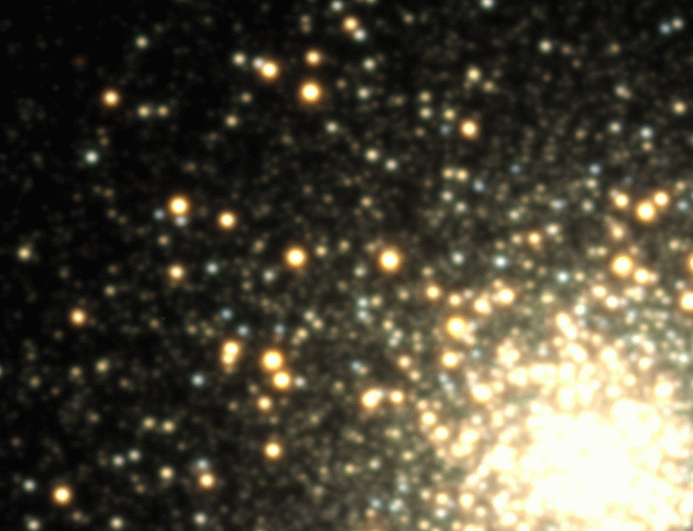
Image courtesy of
Joel Hartman
The answer is simple: we want to check our stellar models for these important stars. Over the years, astronomers have created increasingly sophisticated models of stellar interiors to explain the pulsation of RR Lyrae stars. For example, Szabo, Kollath and Buchler (A&A 425, 627, 2004) follow the evolution of RR Lyr stars over time. Note the difference in the behavior of these two models: one stops pulsing for about 20 million years, while the other continues to vary, although at a decrease amplitude.
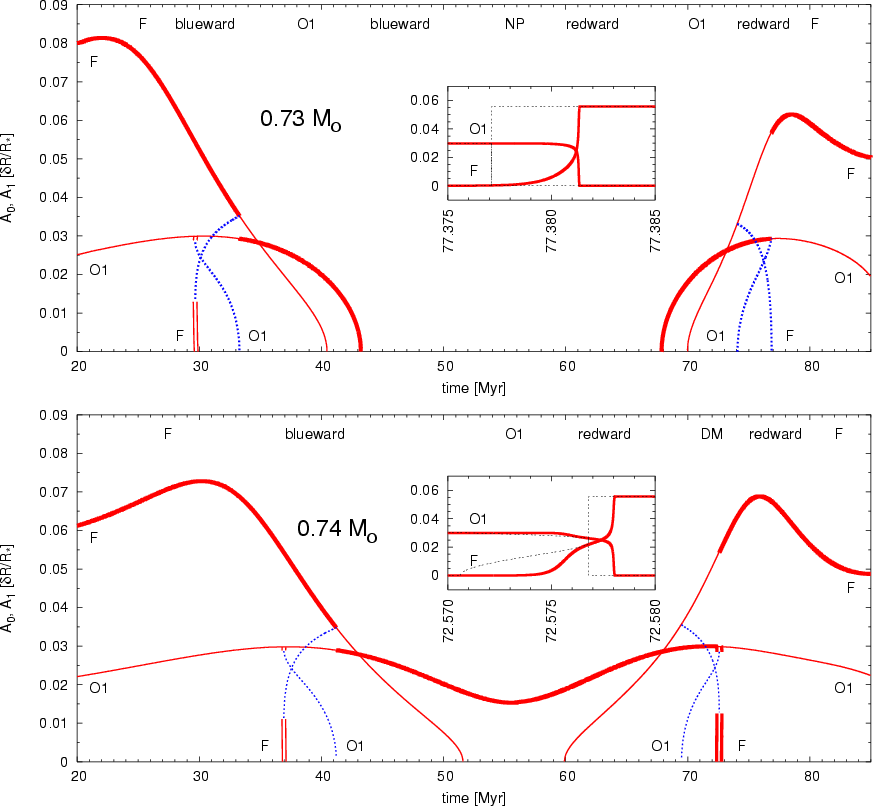
Image taken from
Szabo, Kollath and Buchler (A&A 425, 627, 2004)
However ... note the difference in mass between the two models: just 0.01 solar masses. If we are to check our models against real stars at this level of precision, we need to know the mass of real RR Lyr stars to a similar precision.
But the problem is -- we DO NOT know the mass of any RR Lyr star in a model-independent manner. The only reliable method to measure the mass of a star is
Stars in an eclipsing system give us an added bonus: in addition to the mass of the stars, we can determine the radius of each member from the duration of the eclipses.

One year ago, June 16, 2010, astronomers did not know of any RR Lyr stars in binary systems. But ... if we happened to find an RR Lyr star which showed eclipses, we might be able to acquire radial velocity measurements and so determine the mass and the radius of an RR Lyr star at last.
In the 1990s, astronomers refurbished an old 1.25-meter telescope at Mount Stromlo Observatory, in Australia,
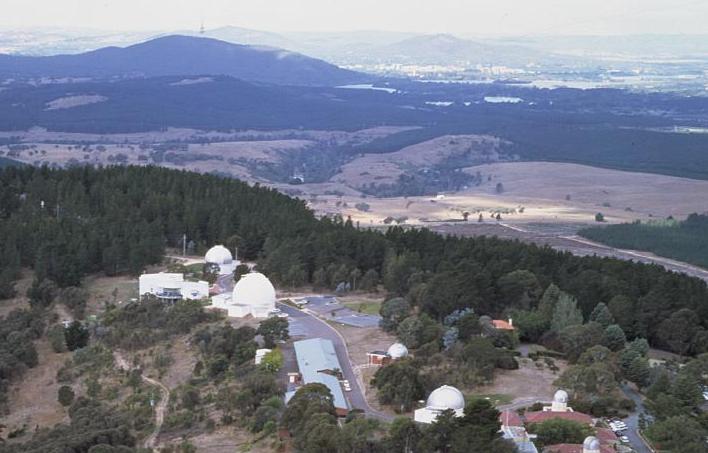
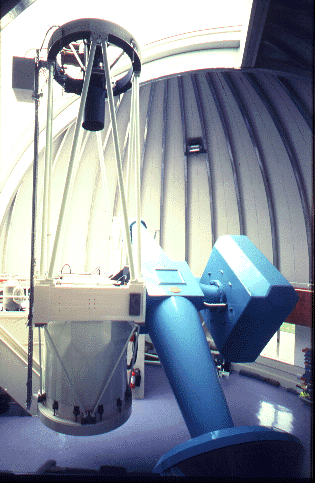
so that it could perform a dedicated search for gravitational lensing events. Some theorists predicted that the Milky Way, in addition to its ordinary stars, had a population of
If this was true, then occasionally one of these MACHOs would pass between the Earth and a more distant star, bending its light rays gravitationally and causing the background star to grow brighter for several days or weeks. However, these microlensing events were predicted to be very rare; so, in order to find them, astronomers of the MACHO Project took pictures of two regions of the sky with very high stellar density (and therefore higher rates of microlensing).
The MACHO team took images of these very rich star fields every night, and measured the brightness of every star in every image. Their camera split the light from each star into "red" and "blue" sections and measured the light in each of these two passbands independently.
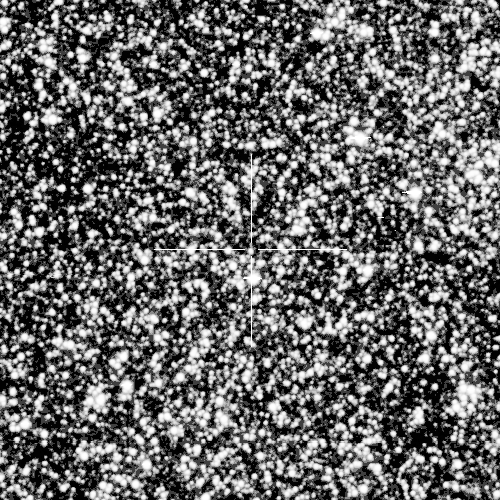
Over the period 1993 - 1999, the MACHO team measured the properties of over 10 million stars in the bulge, with an average of several hundred measurements per star. The data is freely available for all to use.
In 2008, Kunder et al. (AJ 135, 631, 2008) sifted through the MACHO database to look for RR Lyrae stars. They compiled a catalog of 3256 RR Lyr, which can be found at the Vizier catalog site.
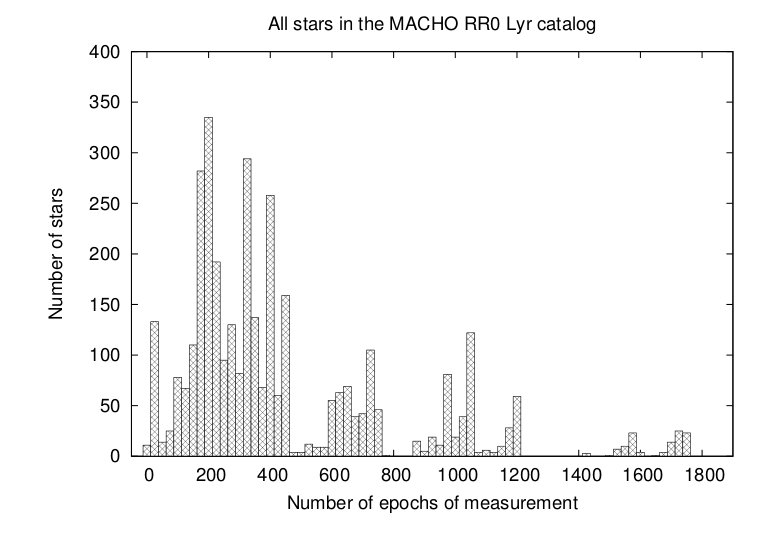
This is where my own work began. My job was to look through data for the 3256 RR Lyr stars and look for evidence of eclipses. In other words, instead of an ordinary light curve like this,
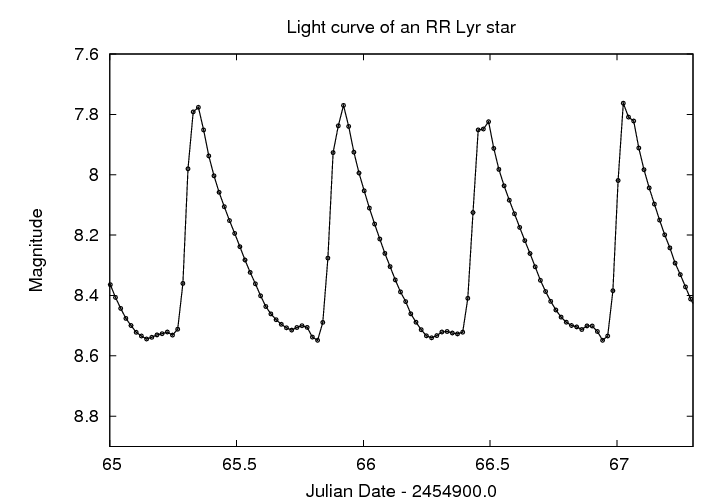
I wanted to find a star which had brief, sharp dips caused by a companion blocking some of its light, like this:
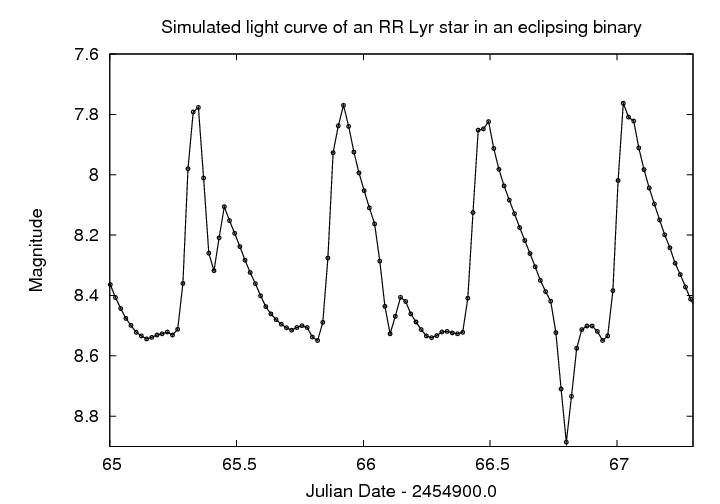
Let me show you the steps I took to perform this search on all those stars.
Step 1 I phased the measurements of each star with the period given by Kunder et al. (AJ 135, 631, 2008). I created a very simple model of the light curve in each passband by
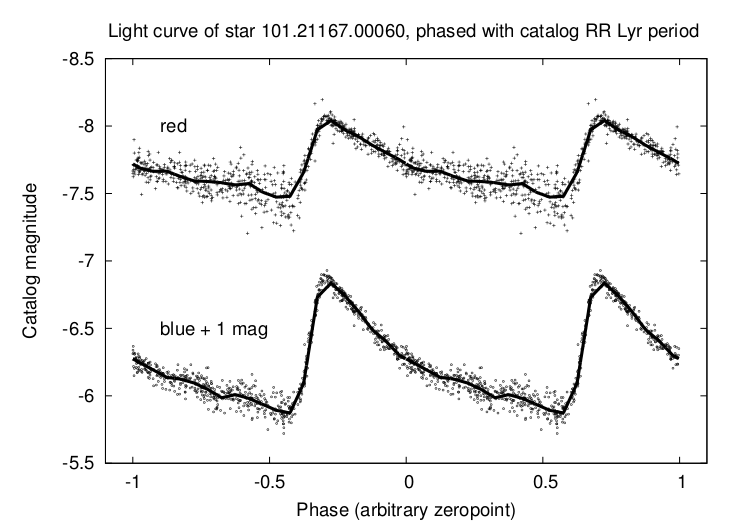
Step 2 I subtracted this model from the measurements, leaving a set of residuals in each passband.
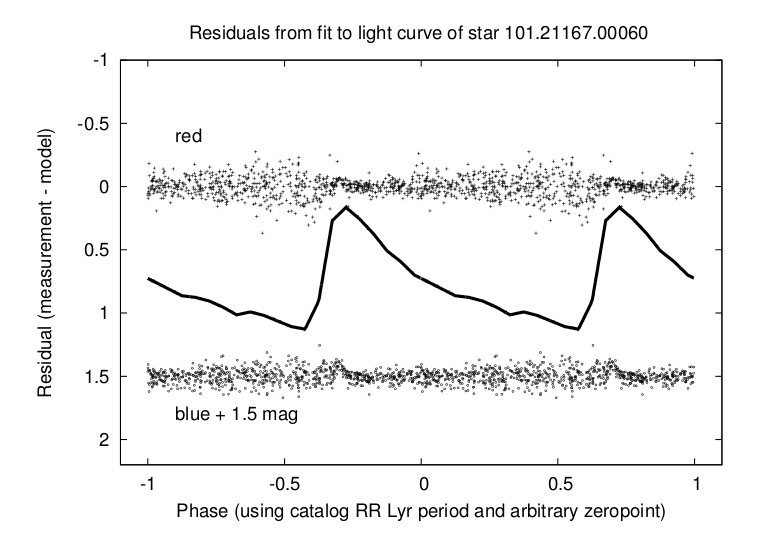
Step 3 Search for periodic variations in the residuals. I applied the "string length technique" described by Dworetsky (MNRAS 203, 917, 1983) to look for periods in the range 0.10 - 100 days, with a spacing of trial frequencies of 0.0001 cycles per day. My computer was able to carry out this search in just a few hours; it made a list of the 10 best candidate periods, and a graph showing the data phased with the best 3 periods.
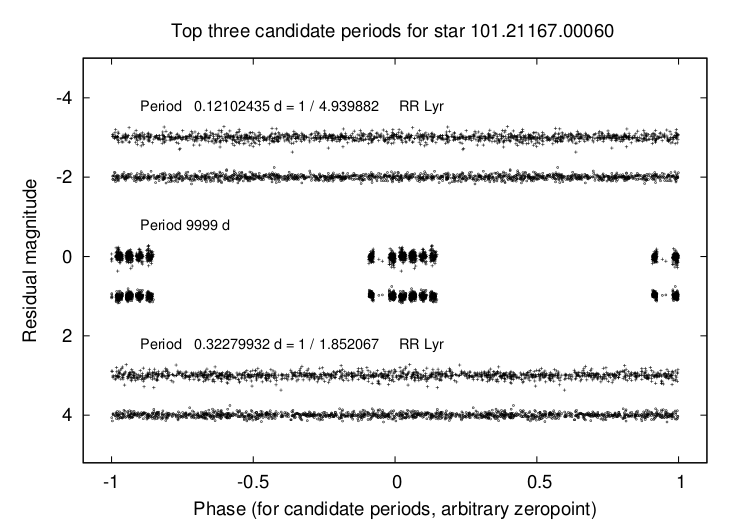
Step 4 (the long and tedious one) I quickly discovered that there were many reasons for the period-finding method to yield a false result. I learned that, in order to make sure that a candidate period was truly due to eclipses, I had to examine every possibility myself.
After a LOT of very tedious effort, I was able to pick out the "best" candidates: stars which showed some sort of periodic variation in their residuals.
3256 RR Lyr ---> 11 possible variables
This is one of the best:
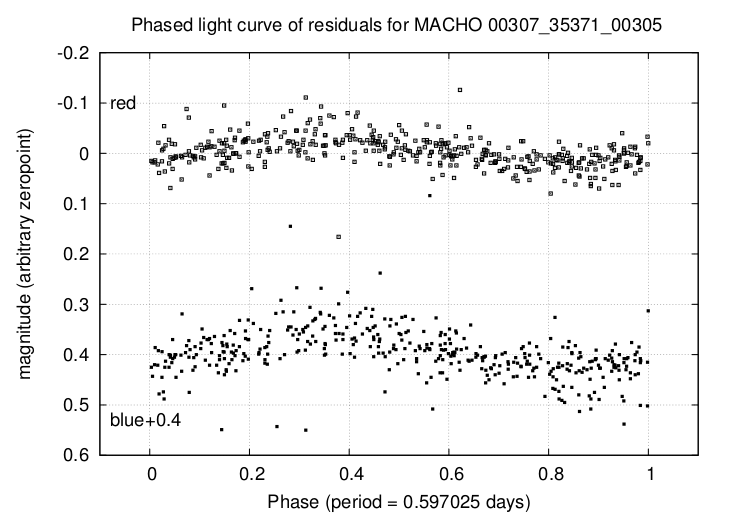
Yes, it certainly does show periodic variations .... but they aren't the sharp, brief dips that would indicate eclipses in a detached binary. These gentle, rolling variations might be caused by the gradual changes in the geometry of a contact binary ....
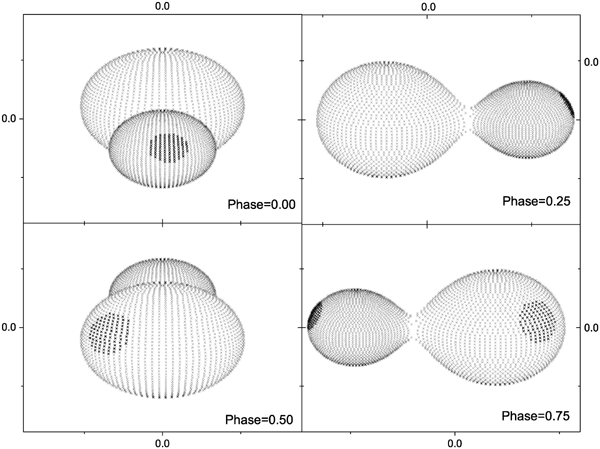
Figure taken from
Qian et al. AJ 136, 2493 (2008)
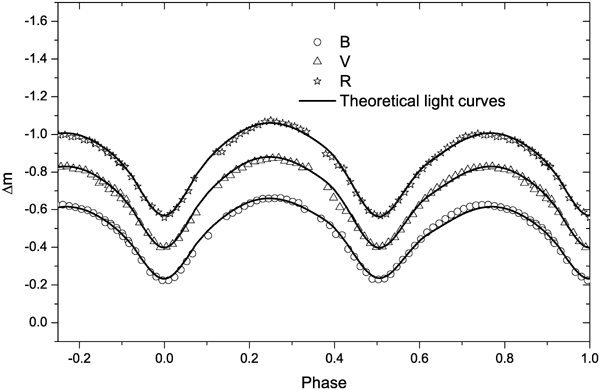
Figure taken from
Qian et al. AJ 136, 2493 (2008)
But ... these variations might not be caused by any binary companion at all. Instead, they could be aliases of the ordinary RR Lyr light curve. An alias is an artifact caused by inadequate sampling of the light curve. The MACHO data usually provide one measurement on every clear night, which means less than one datum per cycle.
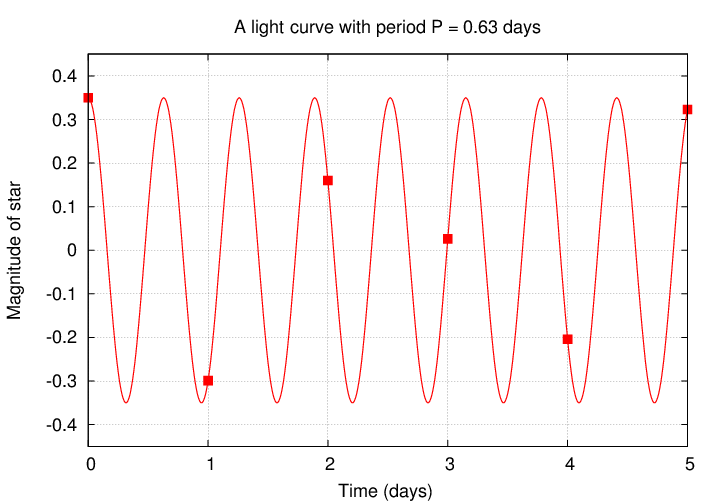
Because the data are so poorly sampled, it is easy to find incorrect periods which are longer than the true period ...
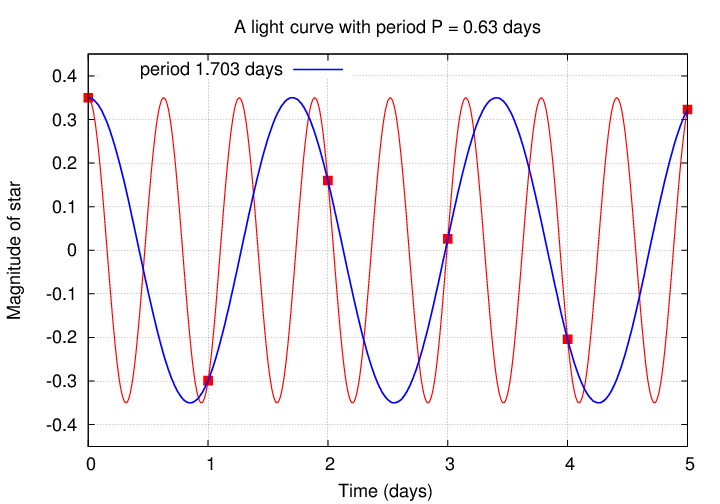
... or shorter than the true period.
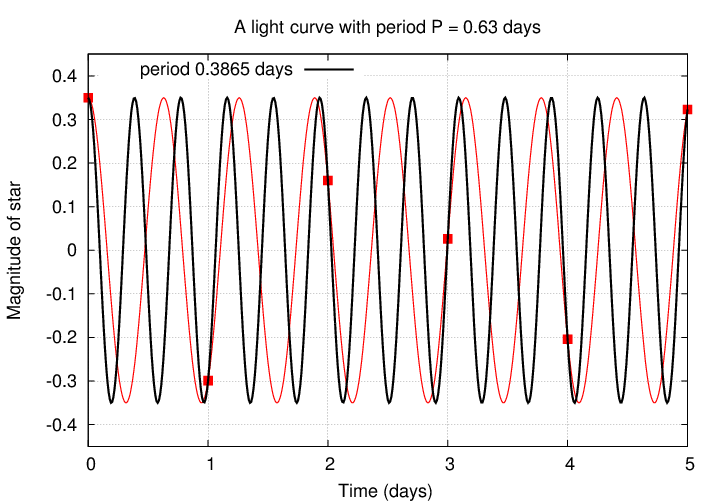
In fact, of the 11 best candidates I found, 8 turned out to be obvious aliases.
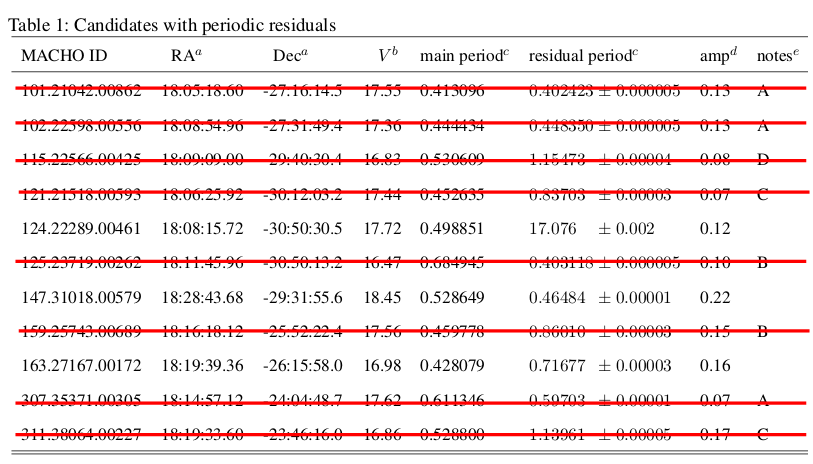
That leaves just 3 stars which might be eclipsing binaries. However, as I will explain shortly, there are good reasons to reject all 3 of these candidates.
After I finished my analysis, I happened to see another paper on a very similar topic:
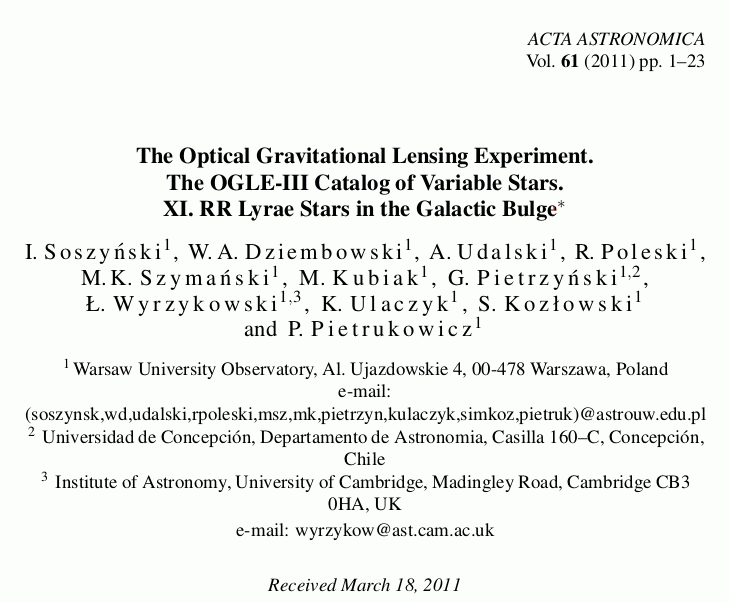
The OGLE project was another effort to detect gravitational microlensing; like MACHO, it made repeated measurements of millions of stars over a period of many years. The OGLE team started with even more RR Lyr variables than I did:
MACHO 3,256 RR Lyr stars
OGLE 16,836 RR Lyr stars
The authors of this paper succeeded in finding 1 very probable eclipsing star. The short, distinct dips indicate that this is a detached binary, so it should be possible to determine the radii of the stars as well as their mass with further study.
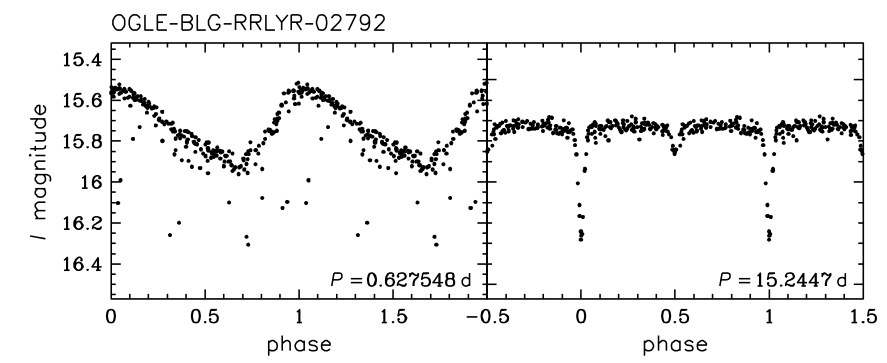
Figure taken from
Soszyński et al., Acta Astronomica 61, 1 (2011)
Let us review the situation:
MACHO 3,256 stars ---> 0 eclipsing binary
OGLE 16,836 stars ---> 1 eclipsing binary
----------------------------------------------------------
20,092 1
That means that only 0.005 percent of RR Lyr stars are found to be in eclipsing binary systems. That is a very low fraction; compare it to these others:
RR Lyr 0.005 % Kepler (mixed type) 1.4 % HATNET (K, M dwarfs) 0.3 % Hipparcos (all types) 0.1 % OGLE LMC (A, B main-sequence) 0.7
Why is it so hard to find RR Lyr stars in eclipsing binary systems? The answer may lie in the evolutionary history of RR Lyr stars. RR Lyrae stars long ago left the main sequence, travelled up the red giant branch, and then back down before settling into their helium-burning phase.
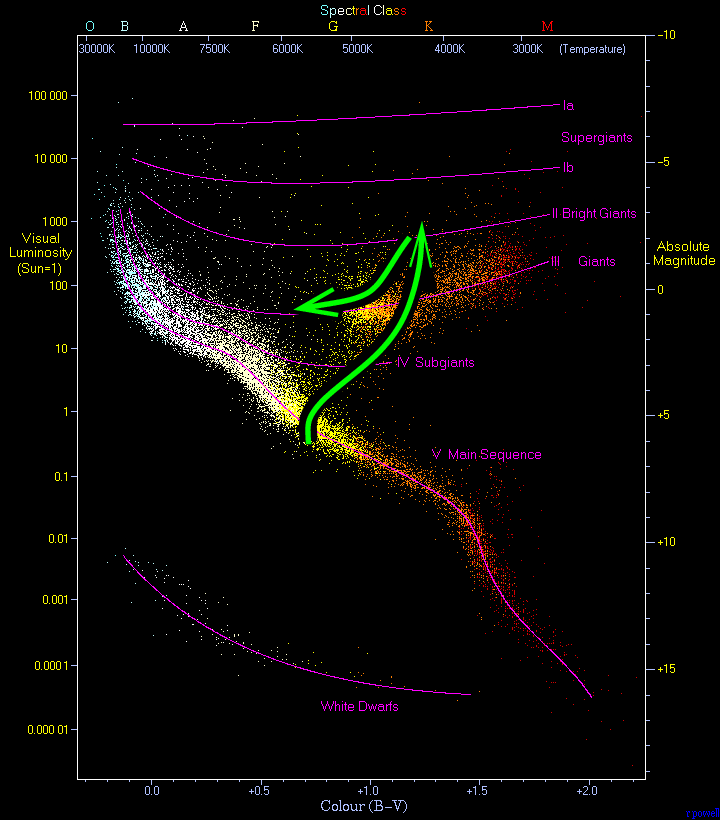
How much did they expand during their red giant phase? Using the Padova group's stellar models, we can make some quantitative estimates:
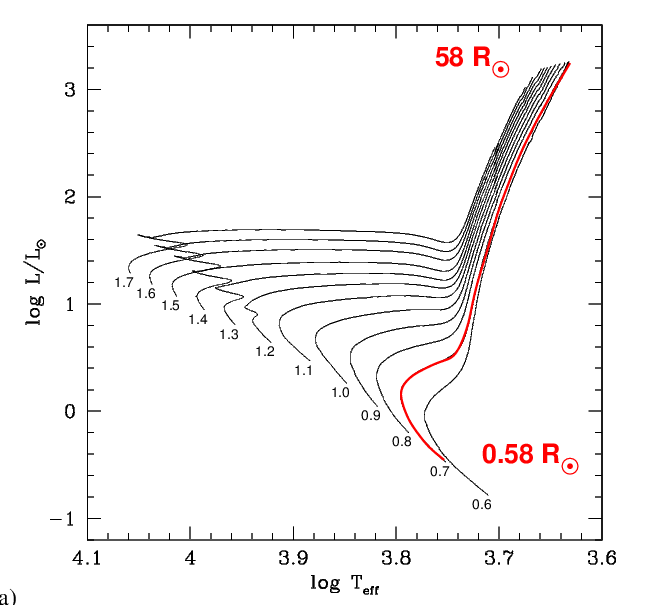
Figure taken from
Girardi et al. A&AS 141, 371 (2000)
This huge increase in size during the red giant phase has important implications for the future of any binary companion. Suppose that the progenitor of an RR Lyr, with an initial mass of 0.7 solar masses, forms with an identical binary companion. We can compute the period of the binary system for any separation.
What will happen to this companion when the star evolves into a red giant?
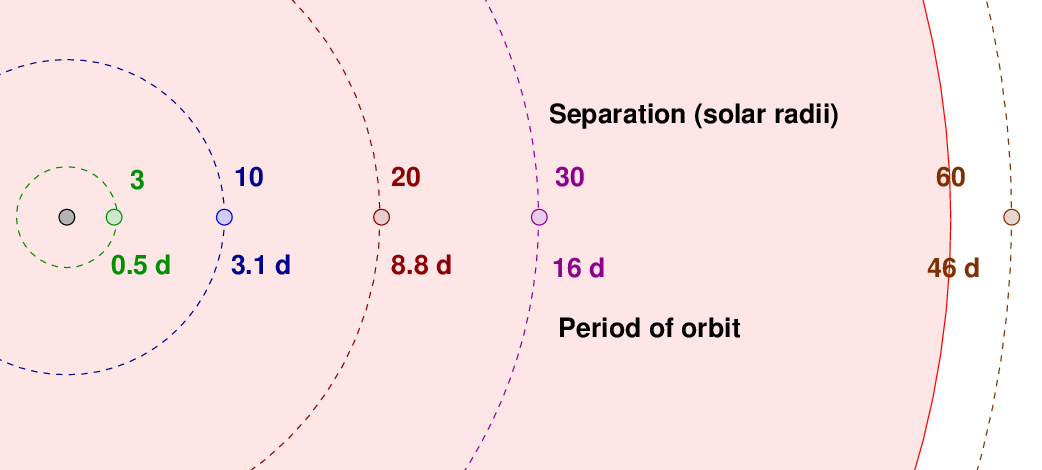
Any binary companion with a period of less than 40 days will find itself inside the red giant for some period of time! It is very likely that close companions would spiral into the red giant as the result of dynamical friction with the envelope.
So, based on this simple view of stellar evolution, we should expect to see no RR Lyr stars in binary systems with short periods.
Go back to my list of 11 possible eclipsing binary candidates. Recall that 8 of the 11 were aliases of the RR Lyr period -- they are marked with red lines. We can now reject 2 of the remaining candidates, because the periods are much too short to have survived the red giant phase.
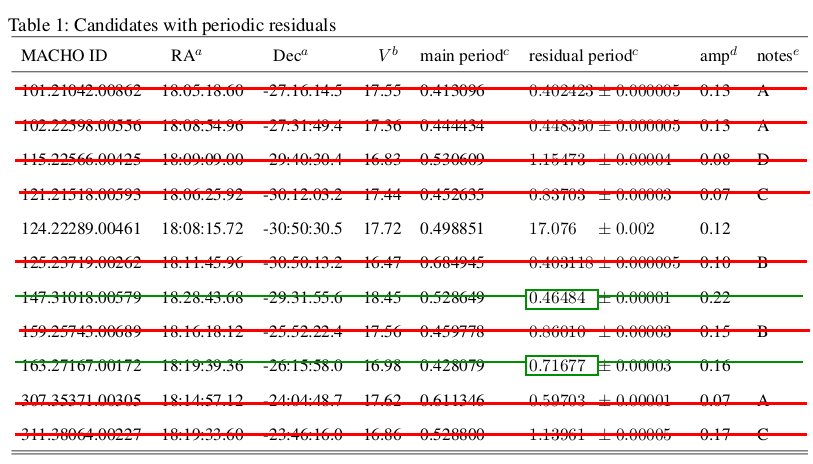
That leaves just one candidate as a possibility. Even this candidate is unlikely because
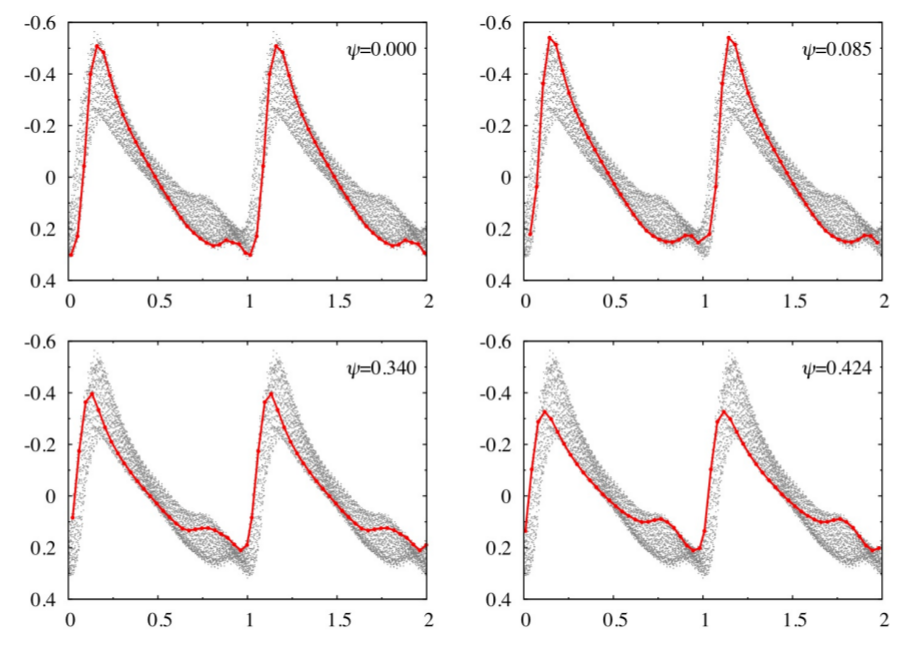
Figure taken from
Kolenberg et al., MNRAS 411, 878 (2011)
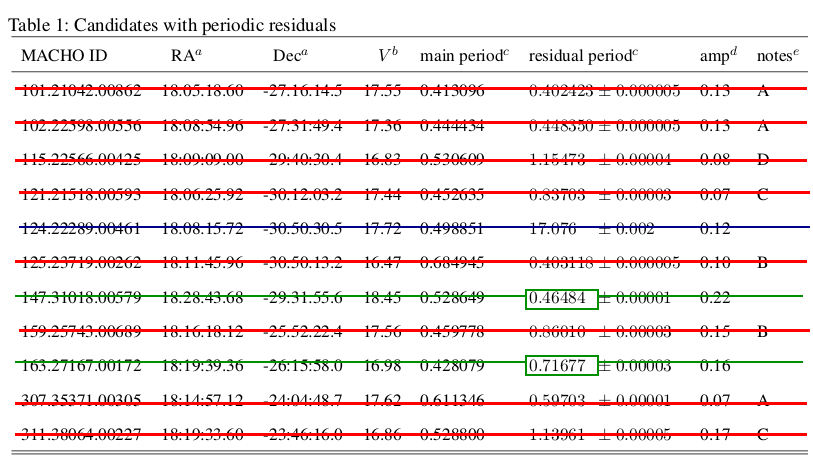
I conclude that my search for RR Lyrae stars in eclipsing binary systems was a failure.
 Copyright © Michael Richmond.
This work is licensed under a Creative Commons License.
Copyright © Michael Richmond.
This work is licensed under a Creative Commons License.